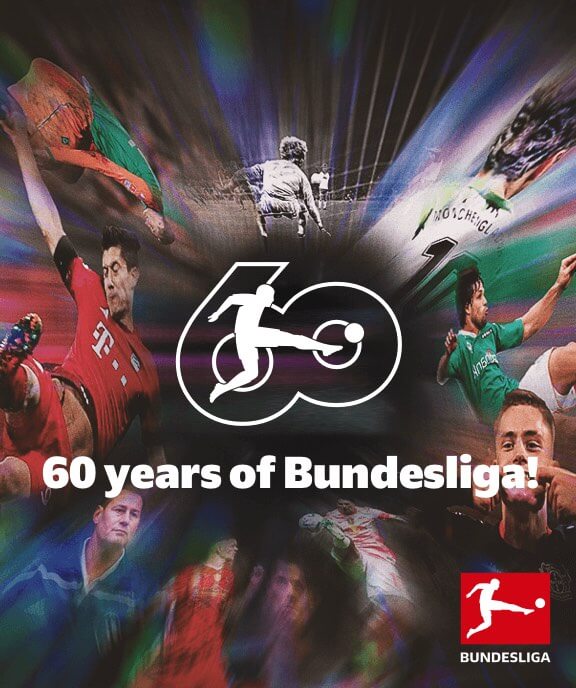
The history of the Bundesliga logo
Football fans across the globe can recognise the Bundesliga logo even from just the briefest of glimpses, but how and when did it originate?
bundesliga.com takes a closer look…
Although the Bundesliga – literally meaning ‘federal league’ or ‘national league’ in German - has existed since its maiden season in 1963, it wasn’t until 2003 that the first official logo was established.
It was here that the iconic silhouetted image of a player – with an admittedly chunky physique – leaping in the air, one leg stretched to reach for the ball and the other bent below, was first made public.
The logo was in portrait mode with a red background and the word ‘Bundesliga’ split in two below it in large, bold, black letters.
The logo is not based on any one player in particular, although several have inadvertently copied the logo during matches over the years.
Bayern Munich forward Robert Lewandowski is perhaps the most famous recent example, having executed a moment of brilliant control during a 4-0 Klassiker victory over Borussia Dortmund in November 2019. Jumping in the air to collect a cross at the back post, the Polish forward exquisitely brought the ball under control, producing a near spitting image of the Bundesliga logo as he did so.
Watch: Lewandowski recreates the Bundesliga logo

The logo has been revamped and updated several times since its initial iteration, the first of which arrived in 2006. At first glance there is not a great difference, but there were subtle changes to the tone and shading of the red background, giving it an almost 3D effect, while remaining in portrait mode.
That was followed by a more significant overhaul in 2010, with what at the time was described as a “holistic relaunch [that] includes both a modernisation of the brand logo and a new look for all media areas and proprietary platforms.”
While the essence remained the same – 92 percent of all football fans in Germany at the time recognised the logo, and close to 100 percent of the population was aware of the league itself - the logo switched to portrait mode and was updated to reflect the zeitgeist in an era when social media and smartphones were beginning to take hold.
“The modernised logo is an essential part of the further development of the Bundesliga design,” explained Tom Bender, DFL managing director at the time. “In future, the Bundesliga will present itself to the fan in an even fresher and more contemporary way. The new look will also meet the increased demands of our media partners at home and abroad. In doing so, we are deliberately sticking to the basic shapes and colours of the logo introduced in 2003, which has found great acceptance in a very short time."
So great was its acceptance, in fact, that it was used for the next seven years – albeit with one significant interlude.
To mark the league’s 50th season in 2012/13, the Bundesliga commissioned a special commemorative logo, one of a number of measures and initiatives to celebrate the milestone, including a new TORFABRIK match ball.
“The 50th Bundesliga season is a wonderful occasion to showcase and further develop the attractiveness of the Bundesliga and its clubs,” explained Bender. “We will be doing this throughout the entire 2012/13 campaign.”
What this meant for the logo itself was that the leaping figure was reduced in size and moved inside the ‘0’ of the number ‘50’, while the years of the Bundesliga’s existence were written in smaller type next to it.
The 2010 logo was used again from the 2013/14 season onwards, until the next design changes were deemed necessary in summer 2017, “particularly to accommodate digitisation requirements,” as an official statement explained.
This created sharper, crisper lines, while the red square background was given corner edges, rather than round ones, and the physique of the leaping player given a far more athletic look.
Furthermore, Bundesliga 2 also gained a logo of its own to position it more clearly in its relations with fans, the media and sponsors and thus to additionally strengthen the profile of the competition.
The DFL likewise had its own logo for the first time. In contrast to the Bundesliga and Bundesliga 2 competition logos, which are primarily used in a sports context, the new DFL logo was intended to highlight the league organisation as the core pillar of German professional football for political, social and business purposes.
The Bundesliga logo has remained unchanged since across all platforms, although the league did change its colours temporarily in March 2022 in support of Ukraine following the Russian invasion.
